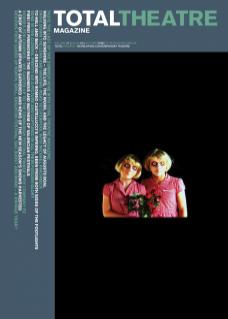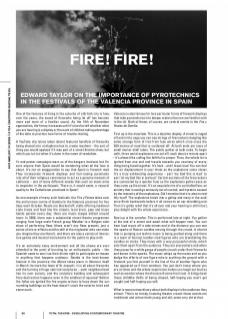One of the features of living in the suburbs of a British city is how, over the years, the sound of fireworks being let off has become more and more of a familiar sound. As the fifth of November approaches, the frenzy increases until it’s hard to tell whether what you are hearing is a display or the work of children taking advantage of the date to practice new forms of trouble-making.
A YouTube clip (since taken down) featured handfuls of fireworks being shoved into a telephone box to create mayhem – the sort of thing you would applaud if it was part of a street theatre show, but which you tut-tut when it’s done in the name of vandalism.
TV and poster campaigns warn us of the dangers involved, but I’m sure anyone from Spain would be wondering what all the fuss is about. It’s not an exaggeration to say that Spain is firework mad. They incorporate firework displays and hair-raising pyromania into all of their religious ceremonies to act as a genuine moment of catharsis – one of many different moods that such an event aims to engender in the participant. There is, it would seem, a visceral quality to the Catholicism practised in Spain!
As one example of many such festivals: the Fira y Festes takes over the entire town centre of Gandia (in the Valencia province) for five days each October. Roads are blocked off; stalls offering medieval-style treats and food line the streets; local drum, pipe and brass bands parade every day; there are music stages dotted around town. In 2008, there was a substantial street theatre programme ranging from large scale French group Malabar to a Belgian sideshow of performing fleas (there aren’t any fleas present, just a series of micro-effects and the skill of the ringleader who can make you imagine they are there!), and there are also a variety of interactive games and musical instruments for the public to play with.
It’s an extremely noisy environment and all the shows are over-attended to the point of bursting by an enthusiastic public – the Spanish seem to see it as their divine right to participate en masse in anything that happens outdoors. Gandia is the best-known festival in the province; the Merce takes place in Valencia itself in March (to mark the feast of St Joseph). It is all about fireworks and the burning of huge satirical sculptures – each neighbourhood has its own society, and the sculpture building and subsequent fiery destruction happens even in the smallest of squares! Before the fallas are ignited the fire engine arrives to hose down the surrounding buildings so the heat doesn’t crack the exterior brick and stone work.
Valencia is also famous for two particular forms of firework displays that take pyrotechnics into deeper waters than we are familiar with in the UK. Both of these, of course, are central events in the Fira y Festes de Gandia.
First up is the mascleta. This is a daytime display. A street is caged off and in the cage you can see strings of firecrackers dangling like some strange form of fruit from fuse wires which criss-cross the 200 metres of road that is cordoned off. At both ends are rows of small mortar-shell tubes. The public gather at both ends. To begin with, three aerial explosions are set off, each about a minute apart – it’s almost like calling the faithful to prayer. Then, the whole lot is ignited from one end and travels towards you courtesy of everything being fused together. It’s loud – and I mean loud. You can feel the air displacement in your chest as the explosions come closer. It’s a truly exhilarating experience – part ‘my God this is loud’ to part ‘oh my God this is too loud.’ Certain sections of the firecrackers are connected by a quicker fuse so the explosions gather pace as they come up the street. It’s an exquisite mix of a controlled fear, an anxiety that it could go seriously out of control, and hysteria caused by the intensity of the explosions. Did I mention that it is also incredibly loud? The explosions break into a gallop and many in the audience flinch backwards before it all comes to an ear-shredding end. Then it’s giddy relief that it’s all over and your hearing is still intact, plus delight with the whole experience.
Next up is the correfoc. This is performed late at night. You gather at the end of a street and await what will happen next. You can hear loud music off a side-street and in the distance you can see the sparks of Roman candles moving through the crowd. A chariot that is pumping out techno music is being pushed along and there is a team of horned, leather-clad figures who are brandishing the candles on sticks. They move with a very purposeful stride, which sets them apart from the audience. They are everywhere and when they pause for a while gangs of people crouch under their fireworks and dance in the sparks. The music whips up the mania and as you dodge the efforts of one figure who is scything the ground with a firework you find yourself in the line of fire of another figure who has appeared as if from nowhere. You just don’t know where you are at times and the whole experience makes you laugh out loud as well as wonder where the threat will come from next. It brings back those childlike thrills of being chased, half-hoping you won’t get caught and half-hoping you will.
What is most extraordinary about both displays is the audience they attract. This is no trendy, knowing theatre crowd: these events are traditional and attract both young and old; some very old at that.
In Valencia, the whole city comes out to watch the mascletas which take place daily (often just after lunch) inside a permanently erected giant cage in the centre of the city. This is no sidelined activity, it’s an important part of the cultural fabric and each mascleta is introduced by the mayor, high on an overlooking balcony. It’s extraordinary to see the city ‘suits’ watching what is basically five to ten minutes of huge explosions with awe and respect… A few adventurous promoters have attempted to promote these kinds of events in the UK, but without the understanding and complicity of the audience, they fail to catch fire in the way they do in Valencia’s towns and cities.
Fira i Festes Gandia Edward Taylor attended Fira i Festes 2008 in Gandia, Valencia (Spain) 1–5 October 2008. Gandia is Valencia’s ‘second city’. The 2009 dates for Fira i Festes Gandia are 29 September – 3 October.
Las Fallas Valencia Las Fallas festival takes place each March in the city of Valencia, capital of the Spanish province of the same name. The focus of the fiesta is the creation and destruction of ninots (giant sculptural structures featuring puppet caricatures of real or fictional characters) which are made from cardboard, wood, papier-mâché and plaster. The ninots are carnivalesque in tone, and usually depict bawdy scenes or satirical takes on current events. They are crafted by neighbourhood organisations and take almost the entire year to construct. The ninots remain in place until 19 March, the day known as La Cremá (the burning) when all of the ninots are set on fire at 12am (midnight) by the local bomberos (firemen). Each year, one of the ninots is spared from destruction by popular vote. This is called the ninot indultat (the pardoned puppet) and is exhibited in the local Museum of the Ninot along with the other favourites from years past.
Lewes Bonfire Society The nearest that the UK gets to the mayhem and misrule of the Valencian Fallas and Festes is probably Lewes on Bonfire Night (5 November). The town’s seven bonfire societies (jointly known as the Lewes Bonfire Council, spend the year planning their elaborate processions and bonfires for 5 November. The Lewes Bonfire Society’s website warns outsiders to stay away on 5 November, so be warned! See www.lewesbonfirecouncil.org.uk
All images taken from Las Fallas in Valencia. Photos by Milo Foster-Prior


